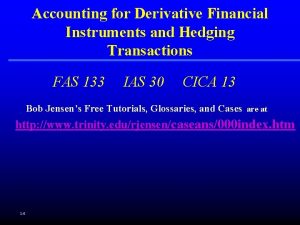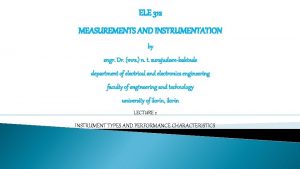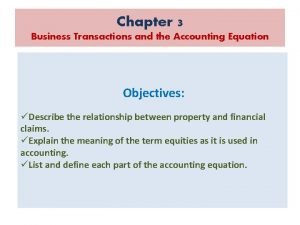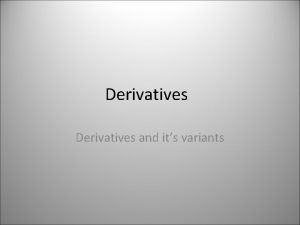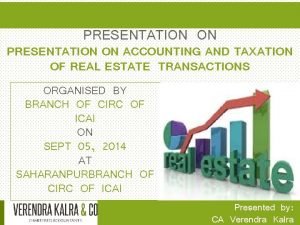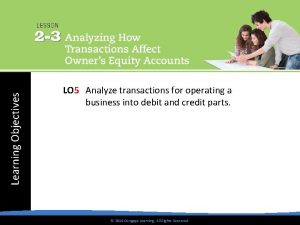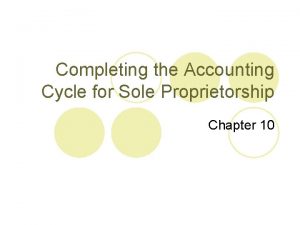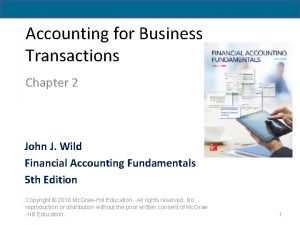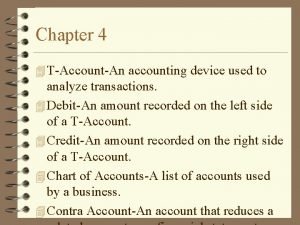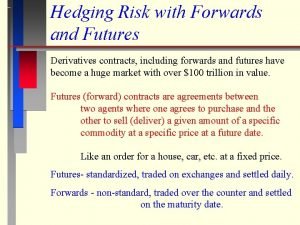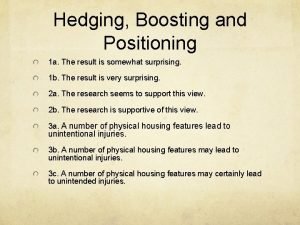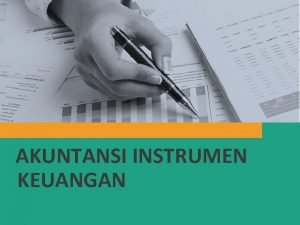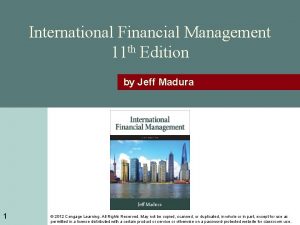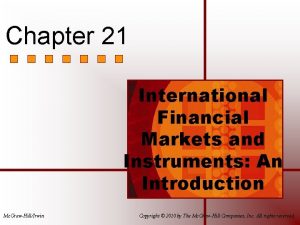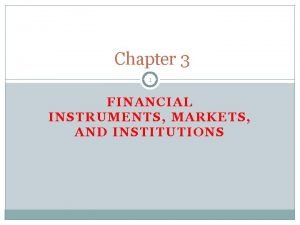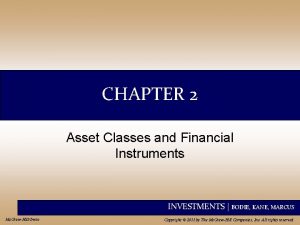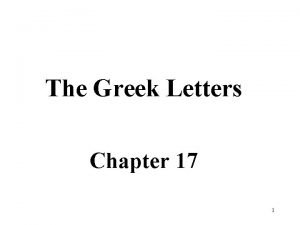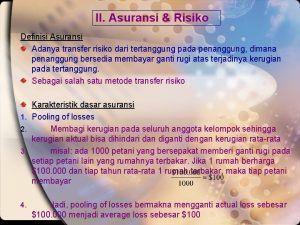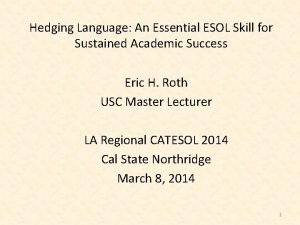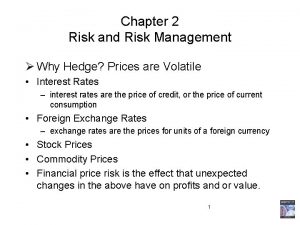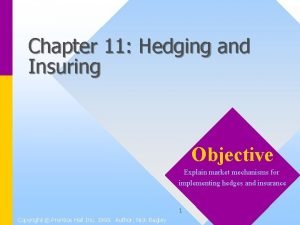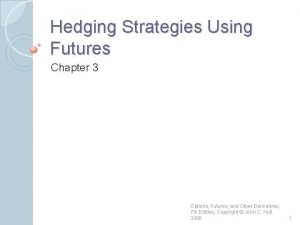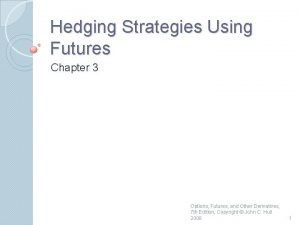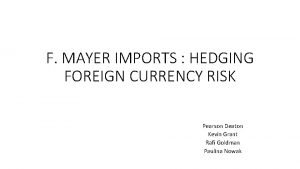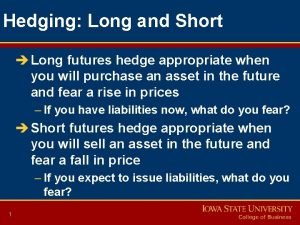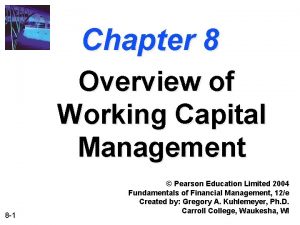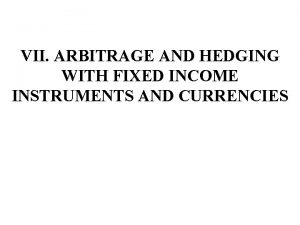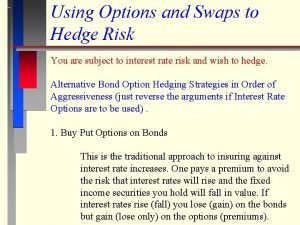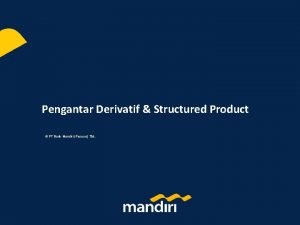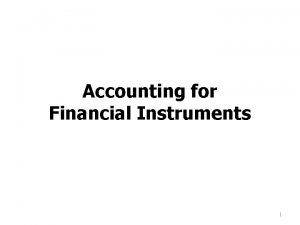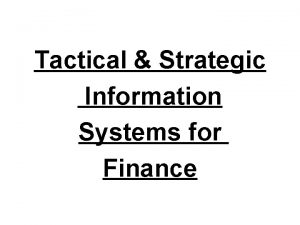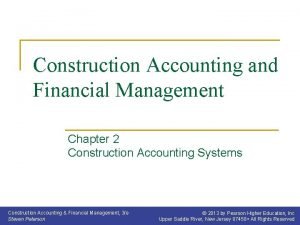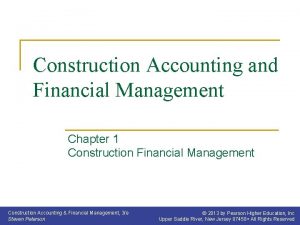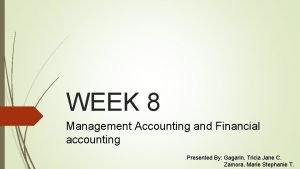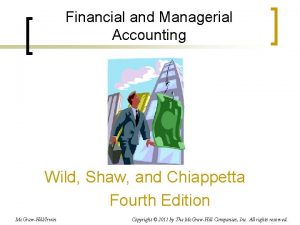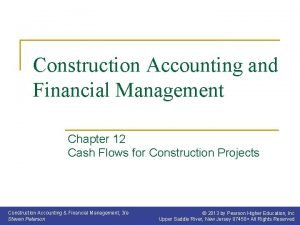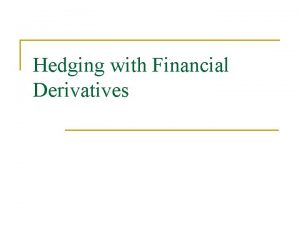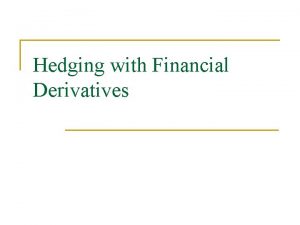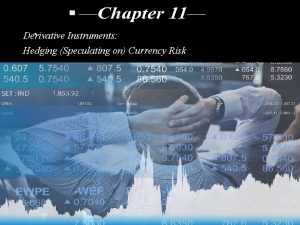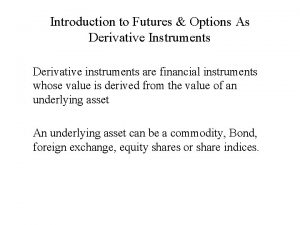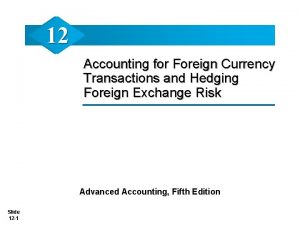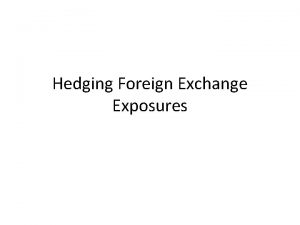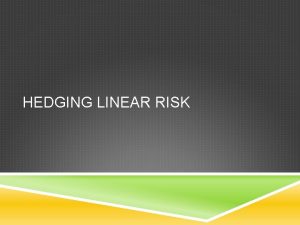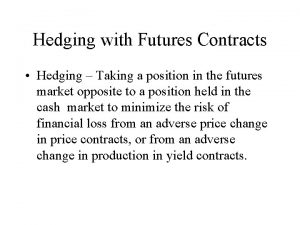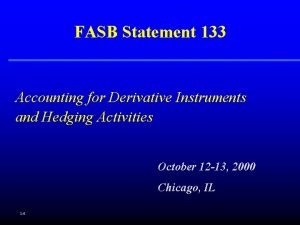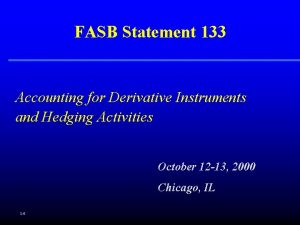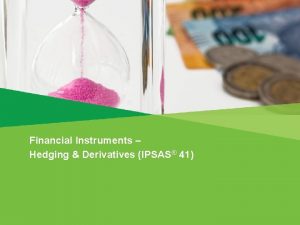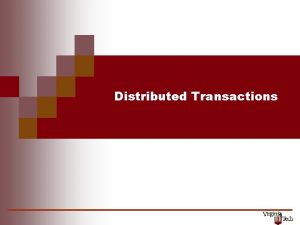Accounting for Derivative Financial Instruments and Hedging Transactions






































































- Slides: 70

Accounting for Derivative Financial Instruments and Hedging Transactions FAS 133 IAS 39 CICA 13 Bob Jensen’s Free Tutorials, Glossaries, and Cases are at http: //www. trinity. edu/rjensen/caseans/000 index. htm 1 -0

ACCOUNTING FOR DERIVATIVES Presentation by Bob Jensen Trinity University San Antonio, TX 78212 rjensen@trinity. edu http: //www. trinity. edu/rjensen/ 1 -1

ACCOUNTING FOR DERIVATIVES Bob Jensen's threads on Enron are at http: //www. trinity. edu/rjensen/fraud. htm Bob Jensen's threads on Derivative Financial Instruments Fraud are at http: //www. trinity. edu/rjensen/Fraud. Rotten. htm#Derivatives. Frauds Also note http: //www. trinity. edu/rjensen/Fraud. htm#Frank. Partnoy. Testimony How Enron Used SPEs and Derivatives Jointly is Explained at http: //www. trinity. edu/rjensen//theory/00 overview/spe. Overview. htm Bob Jensen’s threads on derivatives accounting are at http: //www. trinity. edu/rjensen/caseans/000 index. htm 1 -2

Frank Partnoy’s Works Of all the many documents and books that I have read about derivative financial instruments, the most important have been the books and documents written by Frank Partnoy. Some of his books are listed at the bottom of this message. 1 -3

Frank Partnoy’s Works The single most important document is his Senate Testimony. More than any other single thing that I've ever read about the Enron disaster, this testimony explains what happened at Enron and what danger lurks in the entire world from continued unregulated OTC markets in derivatives. I think this document should be required reading for every business and economics student in the world. Perhaps it should be required reading for every student in the world. Among other things it says a great deal about human greed and behavior that pump up the bubble of excesses in government and private enterprise that destroy the efficiency and effectiveness of what would otherwise be the best economic system ever designed. 1 -4

Frank Partnoy’s Works Testimony of Frank Partnoy Professor of Law, University of San Diego School of Law Hearings before the United States Senate Committee on Governmental Affairs, January 24, 2002 --http: //www. senate. gov/~gov_affairs/0124 02 partnoy. htm 1 -5

Frank Partnoy’s Works n FIASCO: The Inside Story of a Wall Street Trader n FIASCO: Blood in the Water on Wall Street n FIASCO: Blut an den weißen Westen der Wall Street Broker. n FIASCO: Guns, Booze and Bloodlust: the Truth About High Finance n Infectious Greed : How Deceit and Risk Corrupted the Financial Markets n Codicia Contagiosa His other publications include the following highlight: "The Siskel and Ebert of Financial Matters: Two Thumbs Down for the Credit Reporting Agencies" (Washington University Law Quarterly) n n 1 -6

REASONS FOR NEW STANDARDS Undisclosed Assets and Liabilities Unbooked Assets and Liabilities Meaningless Measures of Value & Risk Rise in Scandals in the 1980 s & 1990 s Complex Frauds --- Partnoy’s Fiasco Explosion of Swap Contracts Evolution Toward Fair Value Accounting 1 -7

PROBLEMS WITH NEW STANDARDS Complex Contracts & Technical Jargon Complex Scoping of Coverage --- NPNS Complex Hedge Accounting Rules Many Derivatives Are Difficult to Value Difficult to Find Embedded Derivatives Complex Effectiveness Testing Rules Continuous Stream --- DIG, Amendments Implementation Failures --- Freddie Mac, etc. Held-to-Maturity Interim Distortions Hedge Acctg. Denied to Most Macro Hedges 1 -8

Differences Between Standards FAS 133 vs. IAS 39 vs. CICA 13 Differences are relatively minor IAS 39 Macro Hedging Amendment Listing of Major Differences http: //www. trinity. edu/rjensen/caseans/canada. htm . 1 -9

Hedge Accounting Section Objectives After completing this section, you should be able to: l Determine whether a contract is scoped into the standards and, if so, whether it is – Qualified for Hedge Accounting – Treated as a cash flow, fair value, or FX hedge 1 -10 l Understand the basic journal entries l Cry out loud if forced to implement the standards

One million lines of journal entries: Just how expensive is FAS 133? "The Potential Crisis at Fannie Mae, " Comstock Funds, August 11, 2005 --- http: //snipurl. com/Fannie 133 We have no proprietary information about Fannie Mae, but what is publicly known is scary enough. As you may recall, last December the SEC required Fannie to restate prior financial statements while the Office of Federal Oversight (OFHEO) accused the company of widespread accounting regularities that resulted in false and misleading statements. Significantly, the questionable practices included the way Fannie accounted for their huge amount of derivatives. On Tuesday, a company press release gave some alarming hints on how extensive the problem may be. The press release stated that in order to accomplish the restatements, “we have to obtain and validate market values for a large volume of transactions including all of our derivatives, commitments and securities at multiple points in time over the restatement period. To illustrate the breadth of this undertaking, we estimate we will need to record over one million lines of journal entries, determine hundreds of thousands of commitment prices and securities values, and verify some 20, 000 derivative prices…” “…This year we expect that over 30 percent of our employees will spend over half their time on it, and many more are involved. In addition we are bringing some 1, 500 consultants on board by year’s end to help with the restatement…Altogether, we project devoting six to eight million labor hours to the restatement. We are also investing over $100 million in technology projects to enhance or create new systems related to accounting and reporting…we do not believe the restatement will be completed until sometime during the second half of 2006…” Bob Jensen's tutorials on accounting for derivatives are at http: //www. trinity. edu/rjensen/caseans/000 index. htm 1 -11

FOUR CORNERSTONES n Derivatives are contracts that create rights and obligations that meet the definitions of assets and liabilities n Fair value is the only relevant measure for derivatives (Mainly because historical cost is zero or near-zero) n Value risk can be hedged into cash flow risk, and cash flow risk can be hedged into value risk, but both risks cannot simultaneously be eliminated. n Hedge effectiveness tests can be varied with the type of risk being hedged. 1 -12

Example: Futures Contracts Financial Risk May Be Unbounded n May be contracts to buy or sell at contracted (future) price that moves along with spot prices on an organized exchange linking buyers and sellers. Cost = Zero! n Notional = standardized quantities per contract for a standard product such as a particular type of corn. n Underlying = the value per unit such as the price of a bushel of corn or a Treasury or Libor interest rate. n Futures are a unique kind of derivative because futures gains and losses are posted daily in cash. 1 -13

Example: Futures Contracts (Continued) n Since futures contracts are cleared daily for cash, the accounting was relatively simple under the now-defunct FAS 80. n FAS 133 rules are more complicated for hedging contracts --- see 000 starta. xls file at http: //www. cs. trinity. edu/~rjensen/Calgary/CD/FAS 133 Other. Excel. Files/cases/ n CBOT --- http: //www. cbot. com/ n The prices you first see listed are the forward prices. To find spot prices, click on the link called "Charts. " 1 -14

Example: Forward Contracts Financial Risk May Be Unbounded n May be contracts to buy or sell at contracted (future) price that moves along with spot prices in over-thecounter (OTC) private contracts. Cost = Zero! n Notional = unique quantities per contract for a defined product such as a particular type of corn. n Underlying = the value per unit such as the price of a bushel of corn or a Treasury or Libor interest rate. n Unlike futures contracts, forward contracts are neither standardized nor cleared daily for cash gains and losses. 1 -15

Example: Forward Contracts (Continued) n There were no accounting rules forward contracts prior to FAS 133. n FAS 133 rules are complicated for hedging contracts --see 000 starta. xls file at http: //www. cs. trinity. edu/~rjensen/Calgary/CD/FAS 133 Other. Excel. Files/cases/ n CBOT --- Does not exchange forward contracts n Contracts are non-standardized and might be subject to credit risk. 1 -16

Example: Swap Contracts Financial Risk May Be Unbounded n Swaps are generally portfolios of forward contracts with regularly-spaced payment dates. Cost = Zero! n Notional = unique quantities per contract for a defined product such the number of bonds being hedged. n Underlying = the value per unit such as the price of a bushel of corn or a Treasury or Libor interest rate. n Interest rate swaps were only invented in 1984, but they became the leading form of cash management and now have notionals over $100 trillion dollars. . 1 -17

Example: Swap Contracts (Continued) n There were no accounting rules for swap contracts prior to FAS 133. n FAS 133 rules are complicated for hedging contracts --see 000 starta. xls file at http: //www. cs. trinity. edu/~rjensen/Calgary/CD/FAS 133 Other. Excel. Files/cases/ n There a few standardized swaps traded on exchanges n Contracts are non-standardized and might be subject to credit risk. 1 -18

Example: Written Option Contracts Financial Risk May Be Unbounded n Contracts to sell or buy at contracted (future) price that moves along with spot prices on an organized exchange linking buyers and sellers. Sale Price > $0=Premium! Example: Selling Puts or Calls. n Notional = standardized quantities per contract for a standard product such as a particular type of corn. n Underlying = the value per unit such as the price of a bushel of corn or a Treasury or Libor interest rate. n Options may also be non-standardized OTC. Use of options dates back to Roman times. 1 -19

Example: Purchased Option Contracts Financial Risk Is Bounded by Premium Paid n Contracts to buy or sell at contracted (future) price that moves along with spot prices on an organized exchange linking buyers and sellers. Purchase Price > $0=Premium! Example: Buying Puts or Calls. n Notional = standardized quantities per contract for a standard product such as a particular type of corn. n Underlying = the value per unit such as the price of a bushel of corn or a Treasury or Libor interest rate. n Purchased options are the only derivatives where risk is limited to the premium (purchase) price paid initially. 1 -20

Example: Purchased Options (Continued) n The accounting was relatively simple under the nowdefunct FAS 80. n FAS 133 rules are more complicated for hedging contracts --- see 000 starta. xls file at http: //www. cs. trinity. edu/~rjensen/Calgary/CD/FAS 133 Other. Excel. Files/cases/ n CME --http: //www. cme. com/trading/dta/delayed_quotes 35 20. html n Value of Option = Intrinsic Value + Time Value 1 -21

KEY ASPECTS OF THE 133/39 STANDARDS n Most derivatives are reported at fair value on balance sheet n Changes in fair value for derivatives not qualifying in a hedging relationship are recorded in earnings n Hedge accounting is provided for the change in value of derivatives designated and qualifying as: n 1 -22 l Fair value hedges l Cash flow hedges l Foreign currency hedges Hedge effectiveness tests may be tough hurdles over time

DERIVATIVES IMPLEMENTATION GROUP (DIG) n DIG is made up of FASB staff members, Big 5 members and Industry professionals. Active DIG observers include the SEC and certain regulators. n DIG’s mandate is to assist the FASB in answering implementation questions by identifying practice issues that arise from applying Statement 133 and to advise the FASB staff on how to resolve the issues. n Issues are discussed by DIG, tentatively concluded by the FASB staff and posted on the FASB website (www. fasb. org) for two months before being presented to the Board for negative clearance. n DIG Site http: //www. fasb. org/derivatives/ 1 -23

Bob Jensen’s Flow Chart http: //www. trinity. edu/rjensen/acct 5341/speakers/133 flow. htm n Flow chart for deciding whether derivative is scoped into FAS 133 n Flow chart for deciding how to account for a derivative financial instrument qualified for hedge accounting. Cash Flow Hedge (booked item vs. forecasted transact. ) Fair Value Hedge (booked item vs. firm commitment) Foreign Currency (FX) Hedge (fair value vs. cash flow) 1 -24

DERIVATIVE DEFINITION ¶ 6– 16 n The definition is based on distinguishing characteristics n A derivative instrument is a contract with all three of the following characteristics (¶ 6): l Underlying and either a notional amount or a payment provision or both l Relatively small initial net investment l Net settlement or its equivalent (excludes most short sales & Take-Or-Pays, but see FAS 133 Paragraph 290) n n 1 -25 Definition includes freestanding as well as embedded derivative instruments A number of exclusions exist

FREESTANDING DERIVATIVES Overview n Statement 133 created a new definition of the term derivative n Some instruments that are not usually considered derivatives are included (e. g. certain purchase/sales contracts) n The definition is based on certain distinguishing characteristics. n Certain scope exceptions exist; not everything that meets the definition of a derivative is subject to the requirements of Statement 133. 1 -26

FREESTANDING DERIVATIVES Three Characteristics ¶ 6– 9 and 57 A derivative instrument is a contract with all three of the following characteristics: 1. Underlying and either a notional amount or a payment provision or both 2. No initial net investment or smaller initial net investment than contracts with similar responses to changes in market factors 3. Net settlement or its equivalent 1 -27

FREESTANDING DERIVATIVES Characteristic 1—Underlying ¶ 7 and 57(a) An underlying is a variable, such as: l l 1 -28 An interest rate (e. g. , LIBOR) The price of a security or commodity (e. g. , price of a share of ABC stock or a bushel of wheat) l A foreign exchange rate (e. g. , Euro/U. S. $ spot rate) l A measure of creditworthiness (e. g. , Moody’s) l An index on any of above or other (e. g. , S&P 500, CPI) l Other specific items

FREESTANDING DERIVATIVES Characteristic 1—Notional Amount ¶ 7 A notional amount is a number of: l Currency units l Shares l Bushels l Pounds l Other units Notional amount is used to determine the settlement amount (for example, a price x a number of shares) 1 -29

FREESTANDING DERIVATIVES Characteristic 1—Examples of Underlyings and Notional Amounts Derivative - Stock option Underlying - Stock price - Currency forward - Exchange rate Notional Amount - Number of shares - Number of currency units - Commodity future - Commodity price - Number of commodity units - Interest rate swap - Interest index 1 -30 - Dollar amount

FREESTANDING DERIVATIVES Characteristic 1— Payment Provision ¶ 7 A payment provision specifies a fixed or determinable settlement if the underlying behaves in a specified way. For example: if interest rates increase by say 300 basis points then payment of an applicable amount would be required 1 -31

FREESTANDING DERIVATIVES Characteristic 2— Initial Net Investment ¶ 8 and 57(b) A derivative requires either: l l No initial net investment A smaller initial net investment than other types of contracts that have a similar response to changes in market factors A derivative does not require an initial net investment of the notional amount An exchange of currencies is not a net investment 1 -32

FREESTANDING DERIVATIVES Characteristic 3—Net Settlement ¶ 9 and 57(c) There are 3 ways to meet the net settlement requirement: 1. Net settlement explicitly required or permitted by the contract (transfer of cash or other assets) 2. Net settlement by a market mechanism outside the contract (e. g. , futures exchange) 3. Delivery of a derivative or an asset that is readily convertible to cash 1 -33

FREESTANDING DERIVATIVES Characteristic 3—Readily Convertible to Known Amounts of Cash ¶ 9 and 57(c) Readily convertible assets have: l l Interchangeable (fungible) units Quoted prices available in an active market that can rapidly absorb the quantity held by the entity without significantly affecting the price For example: l 1 -34 Public securities, commodities, and foreign currencies

FREESTANDING DERIVATIVES Exceptions ¶ 10 and 58 The following are not subject to Statement 133: l “Regular-way” security trades l Normal purchases and normal sales l Traditional insurance contracts l Most financial guarantee contracts l OTC contracts with certain underlyings l 1 -35 Derivatives that are an impediment to sales accounting

FAS 138 Scope-Excluded Contracts Normal purchase/sale exception expanded to include: n Contracts that permit net settlement (9 a) n Contracts that have a market mechanism to facilitate net settlement (but note FAS 138) As long as it is probable contracts will not settle net and will result in physical delivery (but note FAS 138 and FAS 149) 1 -36

FAS 138 Scope-Excluded Contracts (Cont’d) Net settlement of similar contracts should be rare Excluded from exception: • Contracts that require cash settlement or otherwise settle periodically • Contracts that have price based on underlying unrelated to asset sold or purchased(1) • Contracts denominated in foreign currency not meeting embedded derivative separation exception rules of paragraphs 15(a) and 15(b) (1) 1 -37 (1) May be considered compound derivatives

FREESTANDING DERIVATIVES Exceptions OTC Contracts with Certain Underlyings ¶ 10(e) and 58(c) Climatic variables: l Temperature l Rain or snowfall totals l Wind speed Geological variables: l Earthquake severity (Richter scale) Other physical variables 1 -38

FREESTANDING DERIVATIVES Exceptions—OTC Contracts with Certain Underlyings ¶ 10(e) and 58(c) The price or value of nonfinancial assets of one of the parties that is not readily convertible to cash or the price or value of nonfinancial liabilities of one of the parties that does not require delivery of readily convertible assets l l 1 -39 Option to purchase or sell real estate owned by one party (even if it can be net settled) Firm commitment to sell machinery (if unique) owned by one party (even if it can be net settled)

FREESTANDING DERIVATIVES Exceptions OTC Contracts with Certain Underlyings ¶ 10(e) and 58(c) Exceptions include specified volumes of sales or service revenues of one of the parties. For example: 1 -40 l Leases based on sales of the lessee l Royalty agreements

FREESTANDING DERIVATIVES Contracts Not Considered Derivatives for Purposes of Statement 133, ¶ 11 n Instruments indexed to an entity’s own stock and classified in stockholders’ equity n Stock-based compensation covered by Statement 123 (issuer only) n Contingent consideration in a business combination covered by Opinion 16 (purchaser only) 1 -41

EMBEDDED DERIVATIVES Definition ¶ 12 n Embedded derivatives are implicit or explicit terms that affect the cash flows or value of other exchanges required by a contract in a manner similar to a derivative n The combination of a host contract and an embedded derivative is referred to as a hybrid contract n Examples of hybrid contracts are: l Structured notes l Convertible securities l Securities with caps, floors, or collars 1 -42

EMBEDDED DERIVATIVES When Does a Contract Have an Embedded Derivative Subject to This Statement? ¶ 12 Yes No Would it be a derivative if it was freestanding? Yes No Do Not Apply This Statement 1 -43 Is it clearly and closely related to the host contract? Yes No Apply This Statement Is the contract carried at fair value through earnings?

EMBEDDED DERIVATIVES Clearly and Closely Related—General ¶ 12 and 60– 61 Clearly and closely related refers to: l Economic characteristics l Risks Factors to consider: l The type of host l The underlying See Flow Chart http: //www. trinity. edu/rjensen/acct 5341/speakers/133 flow. htm 1 -44

EMBEDDED DERIVATIVES Clearly and Closely Related—Underlyings Type of Host 1 -45 Underlying Debt Interest Inflation Creditworthiness Equity Price of share in entity Lease Inflation Interest

EMBEDDED DERIVATIVES Clearly and Closely Related Paragraph 61 provides guidance for determining whether the economic characteristics and risks of the embedded derivative are clearly and closely related to the economic characteristics and risks of the host contract. 1 -46

FAIR VALUE HEDGE ¶ 20– 22 A fair value hedge is a hedge of the exposure to a change in fair value of a recognized asset or liability or of an unrecognized firm commitment attributable to a particular risk. Key aspects: l l 1 -47 Hedged item is exposed to price risk For a highly effective hedge, there must be offsetting fair value changes for hedged item and hedging instrument Changes in fair value of hedged item and hedging instrument are recorded in earnings Basis of hedged item is adjusted by the change in value

FAIR VALUE HEDGE ACCOUNTING Key concepts: n Derivatives are always adjusted on the balance sheet at fair value (i. e. , marked-to-market) (¶ 17) n n In qualified hedge accounting, the offset to changes in the hedging derivative is OCI for cash flow hedges but not for fair value hedges. For a qualified fair value hedge, the offset is = “Firm Commitment” for a purchase contract with a contracted price = “Hedged Item” carrying value if the hedged item such as inventory is already on the books at historical cost = “P&L” current earnings if the hedged item such as inventory is already on the books at fair value 1 -48

FAIR VALUE HEDGE ACCOUNTING For Hedged Item Booked at Historical Cost Accounting Model Measurement of Derivative Change in Fair Value Measurement of Hedged Item Offsetting Gain or Loss Attributable to Risk Being Hedged (1) Ineffectiveness affects net earnings 1 -49 Earnings Changes Offset (1)

CASH FLOW HEDGE ¶ 29– 31 A cash flow hedge is a hedging relationship where the variability of the hedged item’s cash flows is offset by the cash flows of the hedging instrument. Key aspects: 1 -50 • Hedged item may be a forecasted transaction with no contracted future price (i. e. , not a firm commit. ) • Effective portion of derivative’s gain or loss reported in OCI • • Earnings recognition matches hedged transaction Ineffective gain or loss recorded in earnings

CASH FLOW HEDGE ACCOUNTING n Derivative instrument recorded at fair value, effective portion through OCI, ineffective through earnings n Amounts in OCI recognized in earnings when hedged transaction impacts earnings under FAS 133 but not under IAS 39. In other words, IAS 39 requires basis adjustment when the derivative expires whereas FAS 133 carries OCI forward until hedged item is disposed of in a transaction. 1 -51

Accounting Model CASH FLOW HEDGE ACCOUNTING Change in Fair Value Effective Ine (1) ffe cti v e Earnings (1) Based on Timing of Earnings Impact of Hedged Item (interest, cost of sales, depreciation) 1 -52 OCI Equity Measurement of Derivative

FOREIGN CURRENCY HEDGE ¶ 36– 42 (as amended by FAS 138) The Board intended to increase the consistency of hedge accounting guidance by broadening the scope of eligible foreign currency hedges. At the same time, the Board chose to continue certain prior practices. Key aspects: l Includes hedges of cash flow, fair value, and net investments in foreign operations l Carries forward the functional currency concept from Statement 52 l Permits limited use of nonderivative instruments l Expands hedge accounting, particularly forecasted transactions and tandem currency hedges 1 -53

Hedging Instruments n For a fair value hedge of foreign exchange risk related to AFS securities or a recognized foreign-currency-denominated debt instrument, an entity can only use a derivative instrument n For a fair value hedge of foreign exchange risk related to a firm commitment, an entity can use either a derivative or a nonderivative instrument n For a cash flow hedge of a forecasted foreign currency denominated transaction (including forecasted intercompany transactions, recognized foreign-currency-denominated debt instruments and firm commitments accounted for as forecasted transactions), an entity can only use a derivative instrument n For a hedge of a net investment in a foreign operation, an entity can use either a derivative or a non-derivative instrument 1 -54

OBJECTIVE OF HEDGE ACCOUNTING Timing of gain/loss recognition on hedging instrument and hedged item Periods 1 Hedged Item Derivative Total $ -0 - (1) $(20) 20 (2) -0 - $20 1 -55 2 $(20) 20 $(20) $ -0 -

IAS 39 should be applied by all enterprises to all financial instruments except: (a) those interests in subsidiaries, associates, and joint ventures that are accounted for under IAS 27, Consolidated Financial Statements and Accounting for Investments in Subsidiaries; IAS 28, Accounting for Investments in Associates; and IAS 31, Financial Reporting of Interests in Joint Ventures; 1 -56

IAS 39 should be applied by all enterprises to all financial instruments except: (b) rights and obligations under leases, to which IAS 17, Leases, applies; however, (i) lease receivables recognized on a lessor's balance sheet are subject to the derecognition provisions of this Standard (paragraphs 35 -65 and 170(d)) and (ii) this Standard does apply to derivatives that are embedded in leases (see paragraphs 22 -26); 1 -57

IAS 39 should be applied by all enterprises to all financial instruments except: c) employers' assets and liabilities under employee benefit plans, to which IAS 19, Employee Benefits, applies; (d) rights and obligations under insurance contracts as defined in paragraph 3 of IAS 32, Financial Instruments: Disclosure and Presentation, but this Standard does apply to derivatives that are embedded in insurance contracts (see paragraphs 22 -26); (e) equity instruments issued by the reporting enterprise including options, warrants, and other financial instruments that are classified as shareholders' equity of the reporting enterprise (however, the holder of such instruments is required to apply this Standard to those instruments); 1 -58

IAS 39 should be applied by all enterprises to all financial instruments except: (f) financial guarantee contracts, including letters of credit, that provide for payments to be made if the debtor fails to make payment when due (IAS 37, Provisions, Contingent Liabilities and Contingent Assets, provides guidance for recognizing and measuring financial guarantees, warranty obligations, and other similar instruments). In contrast, financial guarantee contracts are subject to this Standard if they provide for payments to be made in response to changes in a specified interest rate, security price, commodity price, credit rating, foreign exchange rate, index of prices or rates, or other variable (sometimes called the 'underlying'). Also, this Standard does require recognition of financial guarantees incurred or retained as a result of the derecognition standards set out in paragraphs 35 -65; 1 -59

IAS 39 should be applied by all enterprises to all financial instruments except: (g) contracts for contingent consideration in a business combination (see paragraphs 65 -76 of IAS 22 (Revised 1998), Business Combinations); (h) contracts that require a payment based on climatic, geological, or other physical variables (see paragraph 2), but this Standard does apply to other types of derivatives that are embedded in such contracts (see paragraphs 22 -26). 1 -60

IAS 39 should be applied by all enterprises to all financial instruments except: 3. IAS 39 does not change the requirements relating to: (a) accounting by a parent for investments in subsidiaries in the parent's separate financial statements as set out in paragraphs 2931 of IAS 27; (b) accounting by an investor for investments in associates in the investor's separate financial statements as set out in paragraphs 12 -15 of IAS 28; (c) accounting by a joint venturer for investments in joint ventures in the venturer's or investor's separate financial statements as set out in paragraphs 35 and 42 of IAS 31; or (d) employee benefit plans that comply with IAS 26, Accounting and Reporting by Retirement Benefit Plans. 1 -61

IAS 39 may apply to insurance companies but not insurance contracts 5. IAS 39 applies to the financial assets and liabilities of insurance companies other than rights and obligations arising under insurance contracts, which are excluded by paragraph 1(d). 1 -62

CASE 1 Cash Flow Hedge of Forecasted Inventory Sale n ABC is hedging the risk of changes in cash flows related to a forecasted sale of 100, 000 bushels of Commodity A to be sold at the end of period 1. The inventory carrying value is $1 million, and current market value is $1. 1 million n On the first day of period 1, ABC enters into Derivative Z to sell 100, 000 bushels at $1. 1 million at the end of period n At hedge inception, the derivative is at-the-money (fair value is 0) n All terms of the commodity and the derivative match (i. e. , no expected ineffectiveness) n On last day of Period 1, fair value of Derivative Z increased by $25, 000 and expected sales price of 100, 000 bushels of Commodity A decreased $25, 000 n From Example 4, Appendix B of Standard 1 -63

CASE 1 Cash Flow Hedge of Forecasted Inventory Sale Journal entries at end of period 1 Derivative Z 25, 000 OCI 25, 000 To record Derivative Z at fair value Cash Derivative Z 25, 000 To record settlement of Derivative Z 1 -64 25, 000

CASE 1 Cash Flow Hedge of Forecasted Inventory Sale Journal entries at end of period 1 Cash 1, 075, 000 CGS 1, 000 Revenue 1, 075, 000 Inventory 1, 000 To record inventory sale OCI 25, 000 Earnings 25, 000 To reclassify amount in OCI to earnings upon inventory sale 1 -65

CASE 1 Cash Flow Hedge of Forecasted Inventory Sale Forecasted cash flows: $1, 100, 000 Actual cash flows: Derivative $ Sale of inventory Total 25, 000 1, 075, 000 $1, 100, 000 The variability of cash flows related to the forecasted inventory sale is offset by change in value of derivative. 1 -66

CASE 2 Fair Value Hedge of Inventory n ABC has 1, 000 bushels of a Commodity with a fair value of $1. 1 million and a carrying value of $1. 0 million n ABC wants to hedge overall fair value of the Commodity n On 1/1/X 1, ABC enters into an at-the-money “matching” derivative to hedge the changes in fair value of the 1, 000 bushels of the Commodity 1 -67

CASE 2 (Cont’d) Fair Value Hedge of Inventory n Effectiveness will be assessed by comparing entire change in fair value of derivative to change in market price of inventory (time value will be ignored for illustration purposes only) n On 1/31/X 1, the fair value of the derivative has increased by $25, 000 and the fair value of the inventory has decreased by $25, 000 1 -68

CASE 2 Fair Value Hedge of Inventory Journal entries at end of period: Derivative 25, 000 Earnings 25, 000 To record derivative at fair value Earnings 25, 000 Inventory To record loss on hedged inventory 1 -69 25, 000
 Derivative instrument
Derivative instrument Intermediate accounting chapter 1
Intermediate accounting chapter 1 Responsibility centers in management accounting
Responsibility centers in management accounting Active instruments
Active instruments Indicating instruments and instruments with a signal output
Indicating instruments and instruments with a signal output Problem 3-5 completing the accounting equation
Problem 3-5 completing the accounting equation Financial derivative definition
Financial derivative definition Analyzing accounting concepts and practices chapter 2
Analyzing accounting concepts and practices chapter 2 An accounting device used to analyze transactions
An accounting device used to analyze transactions Guidance note on accounting for real estate transactions
Guidance note on accounting for real estate transactions 8. an accounting device used to analyze transactions.
8. an accounting device used to analyze transactions. Closing entries sole proprietorship
Closing entries sole proprietorship Analysis of business transaction
Analysis of business transaction 4. an accounting device used to analyze transactions.
4. an accounting device used to analyze transactions. What is journalizing transactions in accounting?
What is journalizing transactions in accounting? Hedging with forwards
Hedging with forwards Hedging and boosting
Hedging and boosting Contoh lindung nilai atas nilai wajar
Contoh lindung nilai atas nilai wajar Hedging receivables and payables
Hedging receivables and payables Tailing the hedge
Tailing the hedge International financial markets and instruments
International financial markets and instruments Financial markets instruments and institutions
Financial markets instruments and institutions Chapter 2 asset classes and financial instruments
Chapter 2 asset classes and financial instruments Hedging in academic writing exercises
Hedging in academic writing exercises Call position
Call position Academic style writing
Academic style writing Transfer risiko adalah
Transfer risiko adalah Hedging in writing
Hedging in writing Hedging adalah
Hedging adalah Cautious language examples
Cautious language examples Hedging manages risk that are manageable
Hedging manages risk that are manageable Main objective of hedging
Main objective of hedging Hedging strategies using futures
Hedging strategies using futures Tailing the hedge
Tailing the hedge F mayer imports
F mayer imports Oil hedging definition
Oil hedging definition Cattle hedging strategies
Cattle hedging strategies Instrumen keuangan derivatif
Instrumen keuangan derivatif Short hedge futures
Short hedge futures Hedging interest rate risk with futures
Hedging interest rate risk with futures Hedging approach of working capital
Hedging approach of working capital Hedge ratio
Hedge ratio Fixed income hedging
Fixed income hedging Hedging credit risk with options
Hedging credit risk with options Hedging adalah
Hedging adalah Futures contract example
Futures contract example Static hedging of exotic options
Static hedging of exotic options Lkas 39
Lkas 39 Financial system
Financial system Financial instruments
Financial instruments Importance of financial services
Importance of financial services Financial method of motivation
Financial method of motivation Tactical information system
Tactical information system Construction accounting and financial management
Construction accounting and financial management Unit 13 accounting and financial statements
Unit 13 accounting and financial statements Financial and managerial accounting weygandt kimmel kieso
Financial and managerial accounting weygandt kimmel kieso Introduction to construction financial management
Introduction to construction financial management Business accounting and financial studies
Business accounting and financial studies Accounting and financial management
Accounting and financial management Financial and managerial accounting wild
Financial and managerial accounting wild Construction accounting and financial management
Construction accounting and financial management Iso 22301 utbildning
Iso 22301 utbildning Typiska drag för en novell
Typiska drag för en novell Nationell inriktning för artificiell intelligens
Nationell inriktning för artificiell intelligens Ekologiskt fotavtryck
Ekologiskt fotavtryck Varför kallas perioden 1918-1939 för mellankrigstiden?
Varför kallas perioden 1918-1939 för mellankrigstiden? En lathund för arbete med kontinuitetshantering
En lathund för arbete med kontinuitetshantering Kassaregister ideell förening
Kassaregister ideell förening Personlig tidbok
Personlig tidbok Anatomi organ reproduksi
Anatomi organ reproduksi Densitet vatten
Densitet vatten
